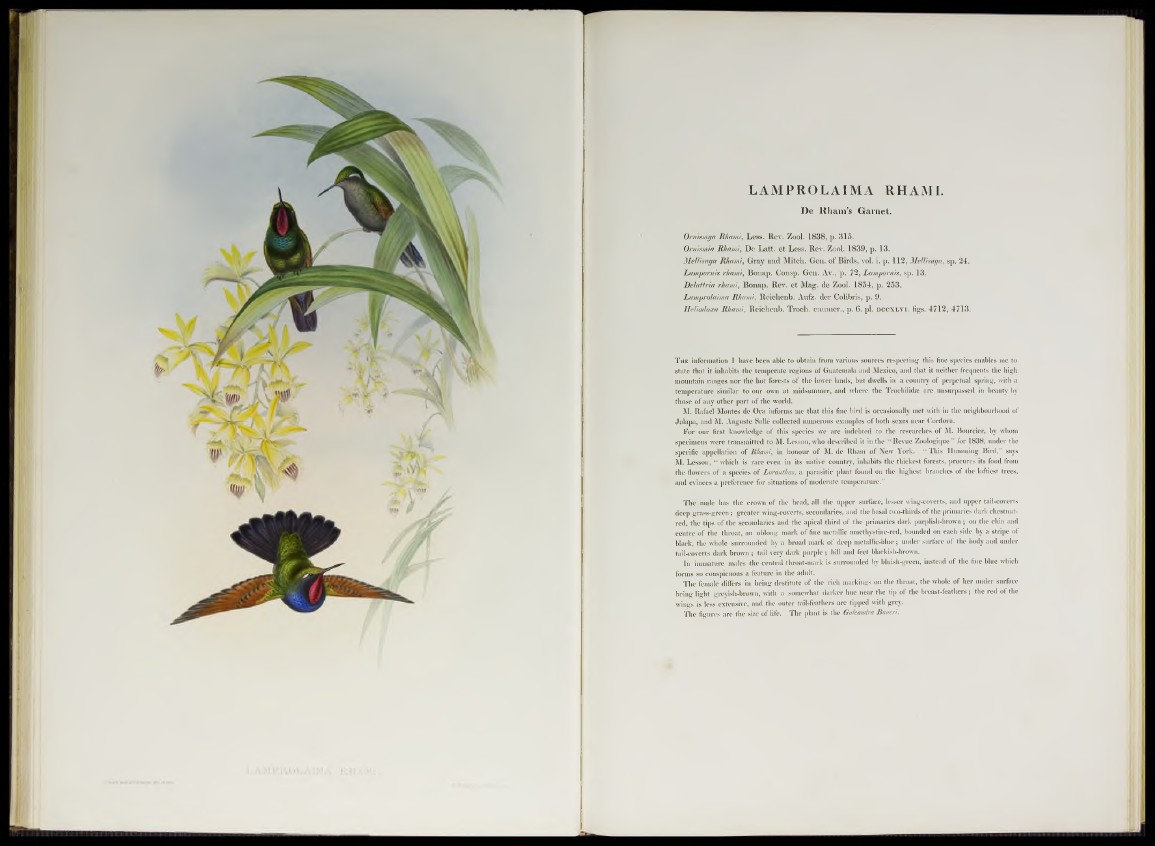
LAM PROL AI MA RHAMI.
De Rham’s Garnet.
Ornismya Rhami, Less. Rev. Zool. 1838, p. 315.
Omismia Rhami, De Latt. et Less. Rev. Zool. 1839, p. 13.
Mellisuga Rhami, Gray and Mitch. Gen. of Birds, vol. i. p. 112, Mellisuga, sp. 24.
Lampornis rhami, Bonap. Consp. Gen. Av., p. 72, Lampornis, sp. 13.
Delattria rhami, Bonap. Rev. e t Mag. de Zool. 1854, p. 253.
Lamprolaima Rhami, Reiclienb. Aufz. der Colibris, p. 9.
Heliodoxa Rhami, Reiclienb. Troch. enumer., p. 6. pl. d c c x l v i . figs. 4712, 4713.
T he information I have been able to obtain from various sources respectiug this fine species enables me to
state that it inhabits the temperate regions of Guatemala and Mexico, and that it neither frequents the high
mountain ranges nor the hot forests of the lower lands, but dwells in a country of perpetual spring, with a
temperature similar to our own at midsummer, and where the Trochilidse are unsurpassed in beauty by
those of any other part of the world.
M. Rafael Montes de Oca informs me that this fine bird is occasionally met with in the neighbourhood of
Jalapa, and M. Auguste Sallé collected numerous examples of both sexes near Cordova.
For our first knowledge of this species we are indebted to the researches of M. Bourcier, by whom
specimens were transmitted to M. Lesson, who described it in the Revue Zoologique ” for 1838, under the
specific appellation of Rhami, in honour of M. de Rham of New York. “ This Humming Bird,” says
M. Lesson, “ which is rare even in its native country, inhabits the thickest forests, procures its food from
the flowers of a species of Loranthus, a parasitic plant found on the highest branches of the loftiest trees,
and evinces a preference for situations of moderate temperature.”
The male has the crown of the head, all the upper surface, lesser wing-coverts, and upper tail-coverts
deep grass-green; greater wing-coverts, secondaries, and the basal two-thirds of the primaries dark chestnut-
red, the tips of the secondaries and the apical third of the primaries dark purplish-brown; on the chin and
centre of the throat, an oblong mark of fine metallic amethystine-red, bounded on each side by a stripe of
black, the whole surrounded by a broad mark of deep metallic-blue ; under surface of the body and under
tail-coverts dark brown ; tail very dark purple ; bill and feet blackish-brown.
In immature males the central throat-mark is surrounded by bluish-green, instead of the fine blue which
forms so conspicuous a feature in the adult.
The female differs in being destitute of the rich markings on the throat, the whole of her under surface
being light greyish-brown, with a somewhat darker hue near the tip of the breast-feathers; the red of the
wings is less extensive, and the outer tail-feathers are tipped with grey.
The figures are the size of life. The plant is the Galeandra Raueri.